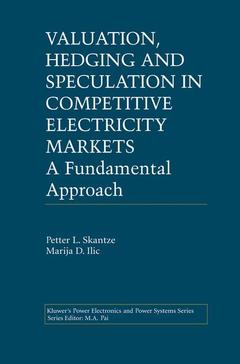Description
Valuation, Hedging and Speculation in Competitive Electricity Markets, Softcover reprint of the original 1st ed. 2001
A Fundamental Approach
Power Electronics and Power Systems Series
Language: English
Subject for Valuation, Hedging and Speculation in Competitive...:
Keywords
Electricity Markets; electricity; model; modeling; network; transmission
Valuation, Hedging and Speculation in Competitive Electricity Markets
Publication date: 11-2012
214 p. · 15.5x23.5 cm · Paperback
Publication date: 11-2012
214 p. · 15.5x23.5 cm · Paperback
Approximative price 105.49 €
Subject to availability at the publisher.
Add to cart
Valuation, hedging and speculation in competitive electricity markets (POD)
Publication date: 10-2001
Support: Print on demand
Publication date: 10-2001
Support: Print on demand
Description
/li>Contents
/li>
The challenges currently facing particIpants m competitive electricity markets are unique and staggering: unprecedented price volatility, a crippling lack of historical market data on which to test new modeling approaches, and a continuously changing regulatory structure. Meeting these challenges will require the knowledge and experience of both the engineering and finance communities. Yet the two communities continue to largely ignore each other. The finance community believes that engineering models are too detailed and complex to be practically applicable in the fast changing market environment. Engineers counter that the finance models are merely statistical regressions, lacking the necessary structure to capture the true dynamic properties of complex power systems. While both views have merit, neither group has by themselves been able to produce effective tools for meeting industry challenges. The goal of this book is to convey the fundamental differences between electricity and other traded commodities, and the impact these differences have on valuation, hedging and operational decisions made by market participants. The optimization problems associated with these decisions are formulated in the context of the market realities of today's power industry, including a lack of liquidity on forward and options markets, limited availability of historical data, and constantly changing regulatory structures.
Overview of Valuation and Hedging Theory.- 2.1 Valuing a Commitment Option.- 2.2 Market Based Valuation.- Overview of the Competitive Electricity Industry.- 3.1 Description of Market Participants.- 3.2 Electricity Markets.- Arbitrage Pricing and the Temporal Relationship of Electricity Prices.- 4.1 Is Electricity Really Non-storable?.- 4.2 Arbitrage and the Relationship Between Physical and Financial Contracts for Electricity.- Building a Price Model for Electricity Markets.- 5.1 Structure of Model.- 5.2 Modeling Approaches.- A Bid-Based Stochastic Model for Electricity Prices.- 6.1 Load Characteristics.- 6.2 Supply Characteristics.- 6.3 Price as a Function of Load and Supply.- 6.4 Stochastic Load Model.- 6.5 Stochastic Supply Process.- 6.6 Summary of the Bid-based Stochastic Price Model.- 6.7 Calibration of the Bid-based Stochastic Model.- 6.8 The Time-scale Separated Bid-based Stochastic Model.- 6.9 Simulations.- 6.10 Concluding Remarks.- Optimal Futures Market Strategies for Energy Service Providers.- 7.1 Hedging Risk for Energy Service Providers.- 7.2 The Physical and Economic Interaction of Energy Service Providers and their Customers.- 7.3 Problem Formulation.- 7.4 Modeling.- 7.5 Efficient Reformulation of Cost Function.- 7.6 Solution Approaches.- 7.7 The End State Problem.- 7.8 Thoughts on the Complexity of the ESP Hedging Problem.- Valuing Generation Assets.- 8.1 Introduction.- 8.2 A Principal Component Based Price Model for Electricity Spot Markets.- 8.3 Creating a Lookup Table of Cash flows.- 8.4 Linking Simulated Prices to the Lookup Table to Generate Simulated Cash Flows.- 8.5 Concluding Remarks.- 8.6 Figures.- Modeling Locational Price Differences.- 9.1 Introduction.- 9.2 Locational Pricing and Markets for Transmission.- 9.3 Modeling Transmission Rights asa Derivative on Spot Prices.- 9.4 Overview of Existing Price Models.- 9.5 Interactions Between Neighboring Markets.- 9.6 Valuing a Transmission Right.- 9.7 Simulation Based Valuation.- 9.8 Dynamic Hedging.- 9.9 Generalization of the Model to A 3 Node Example.- Investment Dynamics and Long Term Price Trends in Competitive Electricity Markets.- 10.1 Introduction.- 10.2 A Long Term Model for Electricity Prices.- 10.3 Modeling Investment Dynamics.- 10.4 A Dynamic Notion of Reliability.- 10.5 Effects of Government Policy.- 10.6 Concluding Remarks.- Conclusion.- Appendix A.- Appendix B.- References.
© 2024 LAVOISIER S.A.S.
These books may interest you

Electricity Pricing in Transition 158.24 €



